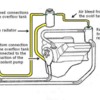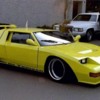I had this in the POCA Newsletter, but thought I’d share here as well
We often talk about modifications we could/should do to our Panteras. And there are plenty of them. We can improve our Panteras by adding stuff that the factory was too cheap to include (they wanted to keep the price down so we could afford to buy their product), or by adding modern advances in technology that were not available when the Pantera was conceived and built. It’s probably the most-modified supercar, and of course a well-modified supercar becomes a super supercar! But some modifications that have been done on Panteras by numerous owners over the years are perhaps not as beneficial as you’d think.
I would group modifications into three groups: those that really do improve the car, those that do improve the car but are compensating for an underlying problem (see a. below) and finally those that do not improve the car at all (b.). Here I’ll focus on the two last types, because in my opinion, you should think twice before you spend your time and money on them.
a. Those in business will probably have heard of the term ‘Lean’. It’s primarily a production term, where all wasteful activities are eliminated. I taught Lean for my local subsidiary of Eastman Kodak in the 80s; back then Lean was called Total Quality Management, or TQM. Kodak called it QLP, Quality Leadership Process. In my opinion, they are all the same thing. One important message was that if you, for example, produced a car on an assembly line, and you had quality problems during the assembly, if you then added a quality inspector at the end who took out the faulty cars and got them sorted out, then of course the customers would receive a better product. But…this was in fact compensating for a problem, instead of correcting a problem. What should happen is that the inspector should go upstream on the assembly line and see to it that the errors are no longer produced. That's correcting the problem, not compensating for it. So when you fix a problem on your Pantera, are you correcting it, or are you in fact only compensating for it?
b. Then we have the modifications that actually make the car worse. Yes, there are some of those out there in the Pantera community. One thing to think about here is, if what I’m doing would have made the car cheaper to produce (for instance, a modification that involves taking parts off the car), why do I think I can make the car better by eliminating what the factory spent money on? And when one really considers that, the answer always becomes the same: the factory was not stupid; they never chose a solution that was both worse and more expensive. Either/or can be justified, but why would they do both? They wouldn’t.
Below I’ll give examples of both a. and b.. I know that some of them are very popular modifications, where we as a group think that we’re cleverer than the factory engineers. So it’ll be heretical reading for many people. But with an open mind, I think you’ll agree that these modifications are either compensating for a problem that should be corrected, or they actually shouldn’t be performed at all… I’ve posted some of these ideas on the POCA forum with little response, but some have caused many objections from those that have done it, and countered with “it worked for me!”. I’m glad it apparently worked for you guys, but maybe not for the reasons you think. The rest of you should read on, and maybe save some time and money that could be spent better elsewhere on your Pantera?
Original Post


 ...Mark
...Mark

